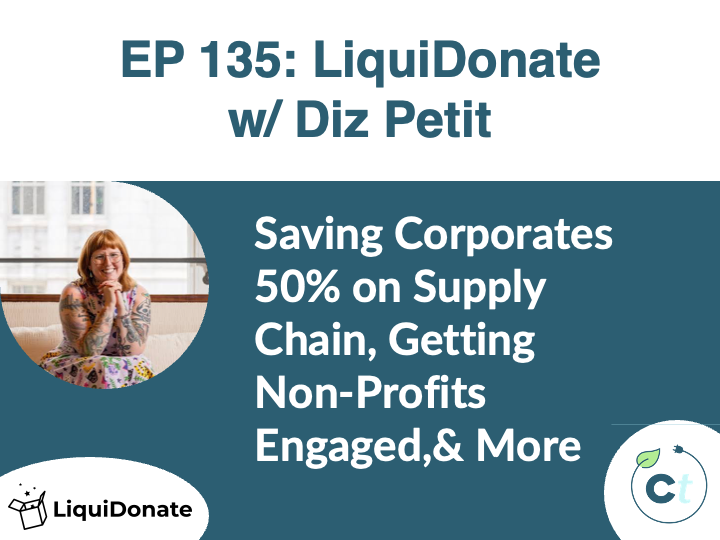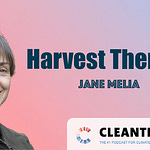🌎 Welcome back to the CleanTechies PodLetter, founder edition. Today we are talking about recommerce.
We are keen to get your thoughts on this new format so let us know if you want to see anything in particular in these longer-form write-ups.
Let’s get into it.
What you’ll find in today’s PodLetter…
Building an Impact-Focused AND Scalable Venture
Aligning Supply & Demand
Financial Incentives
Using Non-Impact-Focused VCs
Takeaways
Show Notes
Carveouts
💡Building an Impact-Focused AND Scalable Venture
A big part of solving the climate issue is reducing waste. Through speaking with our guest today, we learned that ~80% of products that get returned end up in the landfill 🤯. That blew my mind.
Well, thankfully, our guest is helping solve that problem while also saving her clients up to 50% on their reverse supply chain costs (sending a good from customer to vendor).
Our guest is CEO and Co-Founder of LiquiDonate, Diz Petit. She has had an inspiring journey as a social impact entrepreneur. Starting as the 15th employee at Postmates, she played a crucial role in building the operations and customer service teams. In this role, she eventually ended up leading the sustainability initiatives for Postmates after they were acquired by Uber. This experience in product management and her passion for social impact led her to co-found LiquiDonate with a former colleague. LiquiDonate is a software tech solution that enables businesses to donate excess inventory to nonprofits and schools around the world. This diverts the waste and saves the corporates money.
To date, they have diverted 2,069,508 pounds of waste from landfills. 💪🌎
Enjoying the CleanTechies PodLetter? Please show your support by subscribing if you’re not already. We also always appreciate a share. 📩
Aligning Supply & Demand
When dealing with donating, the supply chain is incredibly complex given that although the products may be useful and in good condition, it can be hard to find the buyers for secondhand goods. A huge part of their success was working with all parties to manage the alignment of the demand with the supply.
Financial Incentives
It’s a theme that has come up many times in the show and is equally relevant here. While LiquiDonate is an impact company, they are able to get non-impact-focused companies to sign up with them because they are creating a financial incentive to divert waste. It’s become abundantly clear that in order to have a real shot at massive growth you need to build in these financial incentives to your climate companies.
🚨🚨🚨 Attention Hiring Managers!!! Are you struggling to find qualified candidates? Maybe getting candidates but can’t bring them across the line consistently? Or not getting sufficient applicants? — Reach out to our sponsors NextWave Partners today to help solve that for you.
NextWave Partners is a leading Global Renewables, Climate, & Sustainability recruitment consultancy solely focused on these impact areas. They are also B-Corp Certified.
Reach out to them today to help you solve your hiring challenges and get you one step closer to making an impact.
Using Non-Impact-Focused VCs
They intentionally raised from non-climate VCs to show that even though they are an impact-focused business, they are still a venture-scale company able to get conviction from traditional VCs. They wanted to show that this was not just some tree-hugger-only market (my words not hers). While this isn’t the first time we’ve seen a Climate-venture backed by traditional VCs, it is rare for a founder to seek that out intentionally.
This is something I think other climate founders should look to as an example. While having alignment is super important in raising, you also should think about the non-climate VCs that you could raise from. It is worth noting that this would be easier for software-related business like LiquiDonate compared to hardware.
That’s all for the major notes today. Have been a bit short on time this week and wanted to spend more time with family during Turkey Week 🦃 - Silas
✍️ Takeaways:
Diz had some really great points and was really clear in her message which makes takeaways fun. Here are ours.
Spend a lot of time talking to the market. This might seem old hat, but it’s worth pointing out — the only way they were able to understand the needs of their clients and how the different components of the supply chain interacted with each other was to speak with their potential and existing customers to understand their pain points and needs.
Set the right metrics. When building an impact company, it is important to set metrics that help ensure you are actually making an impact. When deciding on those impacts, lean towards the ones that can more clearly be aligned with financial incentives.
Match Supply & Demand. As we learned, the key to success for LiquiDonate was matching the supply with the right demand. We can take this lesson forward to upcycling and recycling of materials. Identifying waste streams with the proper materials to act as feedstock for producers will be key.
Realistic TAM. Your TAM might actually be lower than you realize if you are only selling to impact-focused brands. If part of your sales process involves appealing to the altruistic and impact-focused aspect of your customers, you’ll have a fraction of the TAM as your realistic TAM. The takeaway here is to not limit yourself to only impact-motivated customers. Identify co-benefits that serve as financial incentives in order to prevent your TAM from being reduced.
Consider non-climate-VCs. As noted above, you should be building a business that, while measured on impact metrics internally, is not incapable of being funded by a traditional VC. Of course, you want to ensure that your VC will bring the right value, but don’t rule out traditional VCs. What they did with intentionally raising from a traditional VC is prove that their impact company was scalable and venture-backable.
📝 Show Notes:
Topics
2:33 Diz & Her Story
6:25 Why Entrepreneurship?
8:02 How to Identify the End User
16:25 Why Would Someone Use Their Software?
18:25 What CSOs Think About This
21:45 Metrics
25:36 Things that Surprised Her
28:49 Their Fundraise Experience
32:54 Advice to Founders
Links
For all your Climate, Renewables, and Sustainability recruitment needs, check out our sponsor NextWave Partners.
🚨 Carveouts:
Silas
On Wednesday, I had the opportunity to sit on a panel at Columbia Business School to offer advice to MBA students on how to recruit for climate jobs. Two main things stood out to me:
There is still an underlying narrative that working in climate requires a person to be highly altruistic and set aside the objectives of making money. Many of the students expressed concern about working in climate for fear of taking a much lower salary and being unable to pay their school loans. This demonstrates the need for us to be shouting from the rooftops that… 📣 “The Climate Revolution will only be successful if we tie carbon reduction and financial success!!! !!!” - okay so maybe that’s a bit aggressive, but it’s true.
If buyers, investors, talent, and regulators think that making REAL money in climate is not going to happen, we are going to be missing a huge portion of participants in this fight.There is a lack of clarity and guidance for young talent to enter into climate. Many folks have very misguided assumptions about the space and how to land a role in the space. This tells me there is no real ecosystem set up to guide them through this journey.
It’s my belief that the way to solve this issue is to have MANY more people sharing their journeys. At some point, someone will set up a really well-organized system for navigating the various areas and ecosystems inside of climate (and maybe they will find consensus on what ClimateTech really means). For now, it needs to be crowd-sourced.
So, that’s my CTA for you - get out there and make some content about the niche you’re in and passionate about!
Somil
This week, I had the chance to speak with a guest with significant developmental finance experience who now invests in climate. The developmental finance → climate finance pipeline is one that fascinates me. I want to use my carve-out to highlight the similarities and why we should spend time looking to successes in development finance as learnings from climate:
They share several similarities as they both aim to derisk the development of solutions that pure market forces have failed to support
Both fields also recognize the importance of committing financial resources to support long-term projects since many of these developments do not succeed in a VC-friendly timeline.
There is a shared need for innovative partnerships and policies given that the economics-of-scale for many of these technologies do not take effect unless a company has significant market share.
Developmental finance as stakeholders greatly resemble family offices and impact VCs — metrics used by both can be subjective to the causes these groups focus on. That can make having a general fundraising strategy difficult if you intend to be selective with the people you are trying to raise from.
If you found this insightful, stay on the look-out for ep 138; more of this to come!
















Share this post